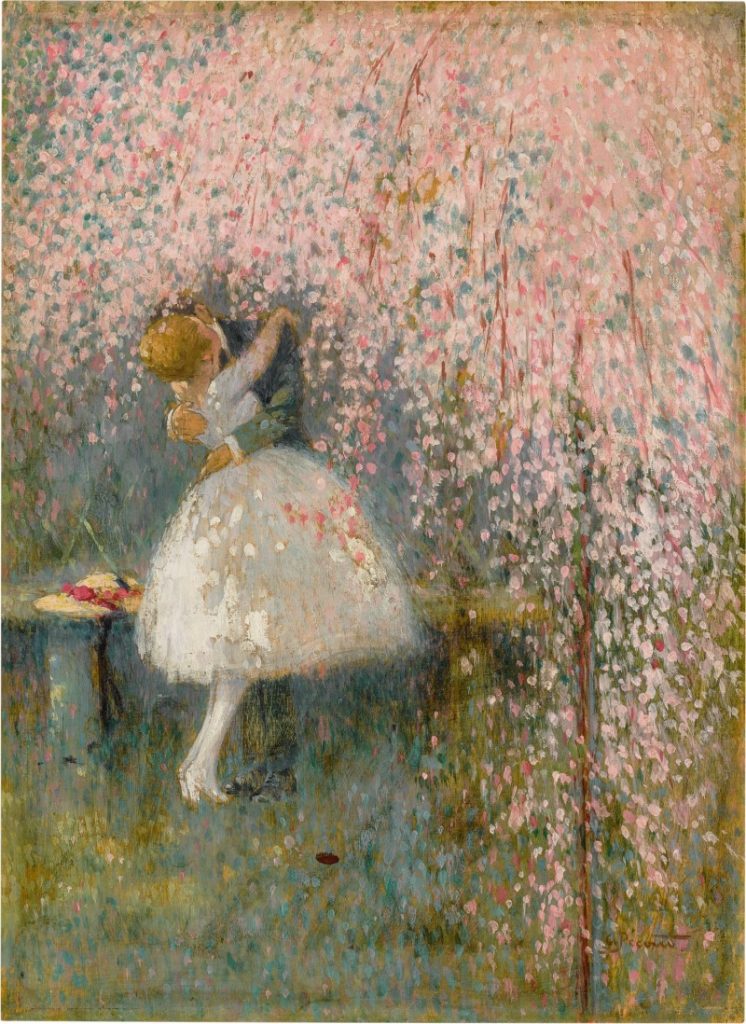
Sous l’Arbre Rose” (Under the Pink Tree) is a distinguished work by the French painter Gaston La Touche (1854-1913), a prominent artist known for his versatility, painting everything from portraits and landscapes to historical and genre scenes. La Touche’s work, characterized by its vibrant color palette, dynamic brushwork, and impressionistic influences, captures the essence of French elegance and the joie de vivre of the Belle Époque era. This article delves into the historical context, artistic significance, and the nuanced elements of “Sous l’Arbre Rose,” offering insights into its place within La Touche’s oeuvre and the broader landscape of late 19th to early 20th-century French art.
Son of Saint-Cloud
Gaston La Touche was born in Saint-Cloud, near Paris, and grew up during a period of significant artistic transformation in France. The second half of the 19th century was a time of rapid change, with the Impressionist movement challenging traditional artistic conventions and exploring new ways to depict light, color, and everyday life. La Touche began his artistic career influenced by the academic traditions of the École des Beaux-Arts but soon found himself drawn to the innovative techniques of the Impressionists. His work, however, cannot be easily categorized into a single movement; it embodies a unique fusion of impressionistic lightness with a more traditional, romantic sensibility.
“Sous l’Arbre Rose” exemplifies La Touche’s mature style, which combines the spontaneous brushwork and light effects of Impressionism with a more structured composition. The painting depicts a leisurely scene of figures gathered under a canopy of blooming pink foliage, likely set in a lush, idyllic garden. This choice of subject matter reflects the Belle Époque’s fascination with leisure and beauty, a time when society enjoyed relative peace and prosperity before the onset of World War I.
Drawing You In
The composition of “Sous l’Arbre Rose” is carefully constructed to draw the viewer into a serene, almost dreamlike world. The central tree, with its vibrant pink blossoms, acts as a natural canopy, enveloping the figures beneath in a soft, dappled light. The use of color in this painting is particularly striking; La Touche employs a palette of delicate pinks, greens, and blues to evoke a sense of harmony and tranquility. This color scheme also reflects the artist’s interest in capturing the fleeting effects of light and atmosphere, a hallmark of Impressionist painting.
One of the notable aspects of La Touche’s technique is his ability to blend detail with a sense of spontaneity. While the figures under the tree are rendered with enough detail to convey their leisurely activities and interactions, the brushwork retains a looseness that imbues the scene with a sense of movement and life. This balance between precision and freedom is a testament to La Touche’s skill as a painter and his ability to capture the essence of a moment.
“Sous l’Arbre Rose” also holds cultural significance, as it represents the idyllic and somewhat idealized lifestyle of the French upper-middle class during the Belle Époque. The painting invites viewers to reflect on the themes of leisure, beauty, and the enjoyment of nature, which were prevalent in the artistic and literary works of the time. It serves as a window into an era where art and life were intertwined in the pursuit of aesthetic pleasure and refinement.
Bridging Artistic Movements
Moreover, the painting is a valuable piece in understanding the evolution of French art at the turn of the century. While La Touche was influenced by the Impressionists, his work also anticipates the decorative qualities and stylized forms of Art Nouveau and the later modernist movements. “Sous l’Arbre Rose” thus occupies a unique position in the history of art, bridging the gap between impressionistic representation and the more abstract, conceptual approaches that would emerge in the 20th century.
In conclusion, Gaston La Touche’s “Sous l’Arbre Rose” is a masterpiece that encapsulates the beauty, elegance, and spirit of the Belle Époque. Through his exquisite use of color, light, and composition, La Touche invites viewers into a world of tranquil beauty and leisurely pleasure. The painting not only showcases the artist’s technical prowess and innovative spirit but also offers insight into the cultural and artistic preoccupations of late 19th and early 20th-century France. As such, “Sous l’Arbre Rose” remains a significant and enduring work, celebrated for its ability to capture the essence of an era and the timeless appeal of nature’s beauty.






